“Hmm, I should really get a sound sample for the before and after on my piano. I’m so confident I can get this thing to work that I want some evidence how broken it was prior to my genius fixing of this machine.”
POP. ZAP. HUMMMMMMMMMMMMMMMMMMMMMMM.
“EEP,” thinks Chris.
HMMMMMMMMMMMMMMMMMMMMMMMMMMMM….
So it seems that I may have broken the amplifier on my Wurlitzer 200A. This after I took my sweet ol’ time getting all the replacement parts in from Mouser. After they finally arrived, I scheduled a time to work on the piano on the weekend to try and fit into my relatively busy schedule.
First inspection of the board shows that this piano has definitely had work done on it before. There are multiple places where the solder joints have been over done with solder (too much globbed up in one place). The resistors and capacitors also do not appear to be the originals, though they still appear to be pretty old and could be the originals.
So what do I think happened? In my onomatopoeic description at the beginning of this article, you may have guessed that there was a short to ground (the “ZAP”). This happened because I was dumb enough to try turning on the piano when it was not bolted to the chassis. The circuit board likely shorted from one of the high potential points to the chassis, which is grounded. In the process, high amounts of current either caused a part to fail catastrophically through material failure (a PN junction having too many carriers “break through”) or thermally (an electrolytic capacitor exploding due to high temperature).
I have a very primitive multimeter intended for use on power lines and such, so it could only tell me the there is 2 volts DC at the speaker output. This is definitely not healthy for the speaker nor the system and leads me to believe the output coupling capacitor may have broken. I will update more once I borrow my friend’s advanced multimeter.
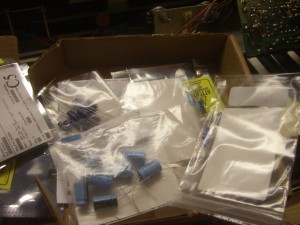
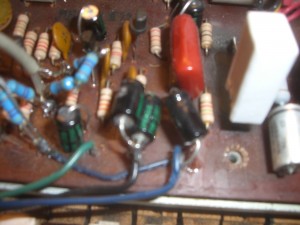

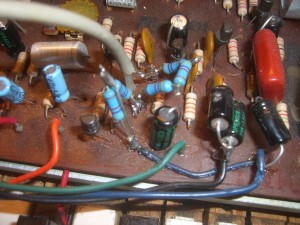
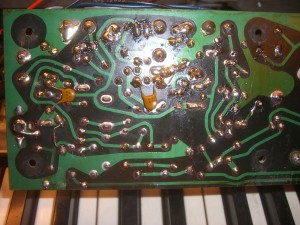
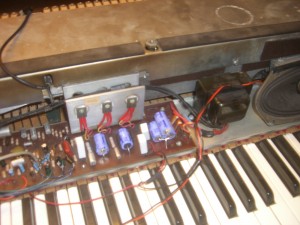
10 replies on “Breaking my Wurlitzer 200A”
[…] Stuff Breaking my Wurlitzer 200A Sep […]
NOOOOOO!!!!
First my Wurli gets stolen, now yours goes kaput!
What ever happened to the Rhodes Suitcase piano from Kenmore, NY that Chelsea Poppenfresh, ahem, Charlie Pencilneck, woops I think I mean Chauncey Peppertooth, used to play on?
The Rhodes resides safely in NYC with Joe. He’s teaching at a music school in Brooklyn I believe, but that Rhodes ended up being pretty messed up too. John thought the harp/tone making section was different than the body and hammers of the piano. How weird is that?
Chauncey lives on though.
[…] lessons I’ve ever learned in electronics was trying to fix something that was already broken. I’m trying to fix a broken piano right now and it’s already been an enlightening experience. In the spirit of all things renewable, why […]
[…] voltages, likely on the order of kV. However, the high voltages have the obvious safety concerns (ZAP!) and the not-so-obvious concerns such as skin effects. Manufacturing a safe product that will pass […]
[…] thought I would update on my hobby subject for tonight since I mostly worked on my Wurlitzer 200A electric piano instead of writing the post I meant to. I’m just now getting back into working on my electric […]
[…] Pat recently came up with a great idea while he looks for work. He has been helping me out with my (still) broken Wurlitzer, taking the old schematic and putting it into a modern CAD program. He gets the experience of using […]
[…] am very excited to announce that the Wurlitzer 200 is fixed and operational. I say Wurlitzer 200 instead of 200A because a nice chap emailed me and let me know that I actually had an earlier […]
[…] few months back I had mentioned how I blew up my Wurlitzer 200 and needed to start troubleshooting it for possible problems. I also lamented the fact that I […]
I am chopping an old 206a into a 200a. To do this I need to solider in the Aux amp and vibrato circuit. I have most of the transistors I need as well as the Vactrol LED/LDR cell I need for the vibrato circuit. However I am having trouble trying to figure out what the values are of three capacitors in the Vib circuit. They are the same capacitors shown in your wurly vib schematic at the beginning of the blog. They are C16, C17, and C18. The service manual as well as the schematic displayed on this blog show non-polarized caps with .12 value assigned to them. But the .12 does not have a unit value attached to it such as MFD, µf, or pf. So do you or anyone else know what the units on those capacitors are!!!! Any advise would be greatly appreciated.